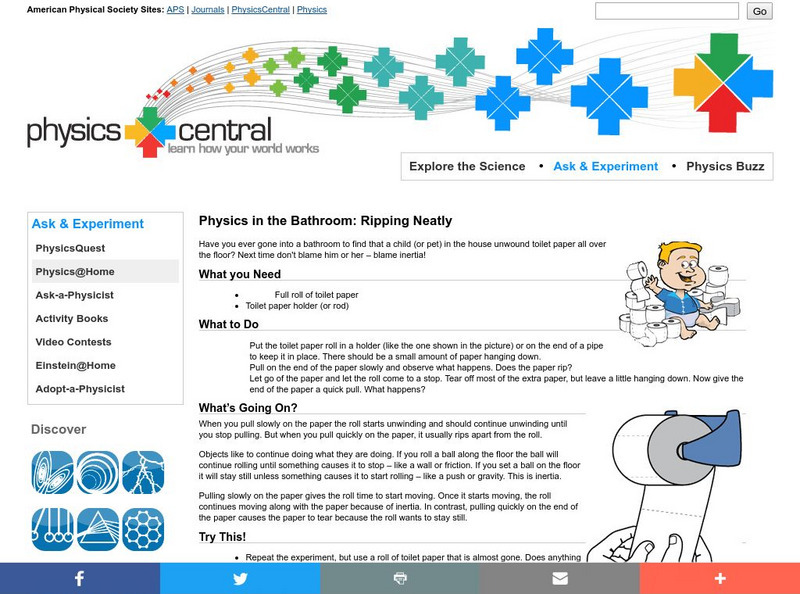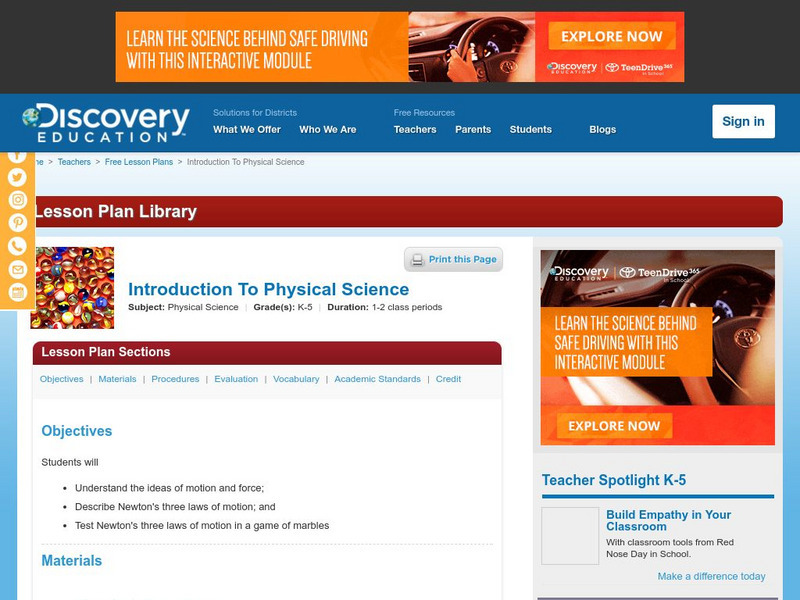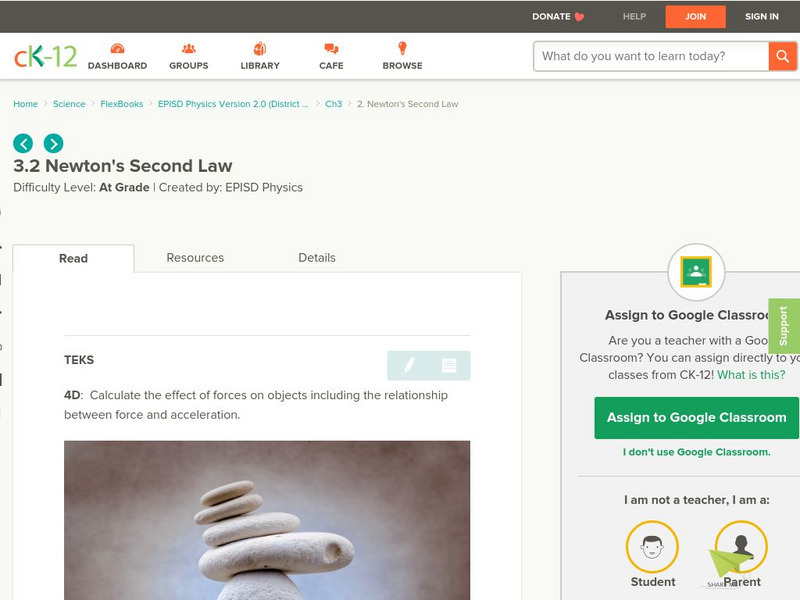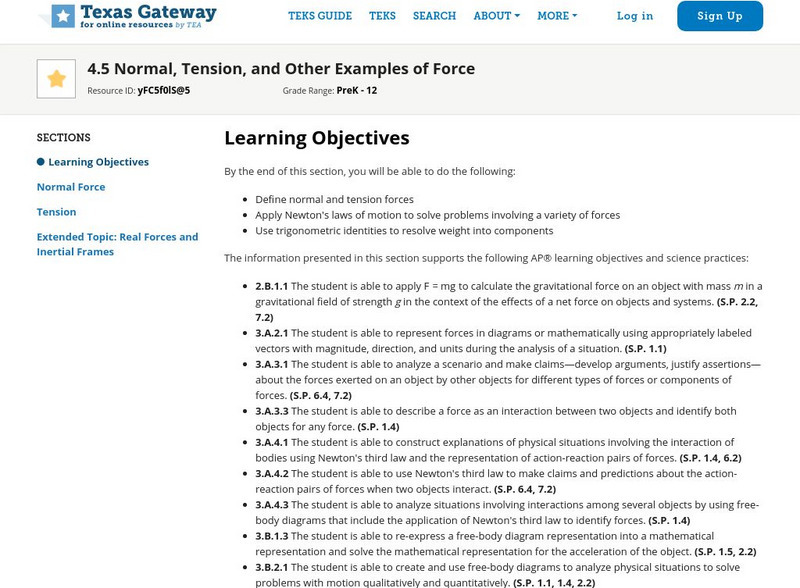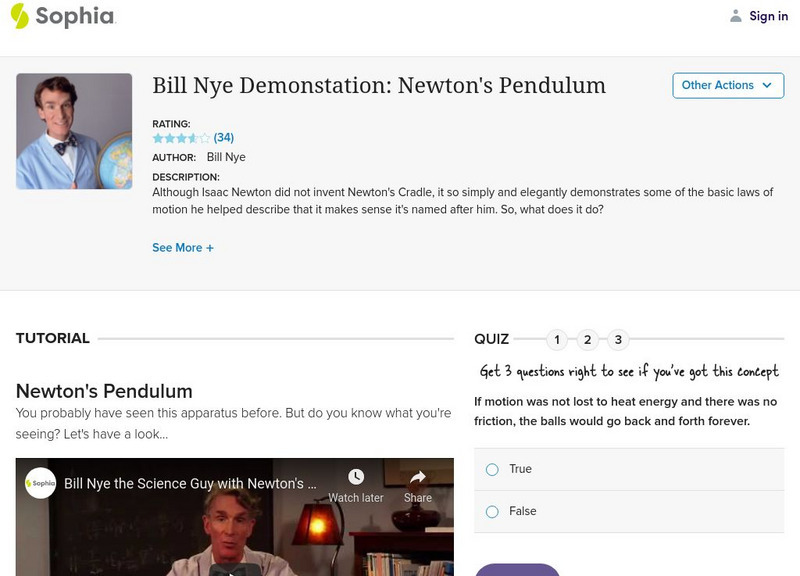Physics Classroom
The Physics Classroom: Newton's Laws
A four-lesson e-textbook covering topics in Newton's Laws. Tutorials include informational text,animations, interactive activities, and quick, interactive comprehension checks throughout the lessons.
Physics Central
Physics Central: Physics in the Bathroom: Ripping Neatly
A great science experiment to demonstrate Newton's First Law of Motion, inertia. There is a step-by-step guide on how to conduct this experiment and links to other sites about inertia.
TeachEngineering
Teach Engineering: Physics Tug of War
In this activity, students will learn about Newton's 2nd Law of Motion. They will learn that the force required to move a book is proportional to the weight of the book. Engineers use this relationship to determine how much force they...
Physics Classroom
The Physics Classroom: Motion and Forces in Two Dimensions: What Is a Projectile
Students apply both kinematic principles and Newton's laws of motion to understand and explain the motion of objects moving in two dimensions, more specifically, the motion of projectiles.
Discovery Education
Discovery Education: Introduction to Physical Science
Introduce students to the ideas of motion and force in this hands-on lesson plan.
Soft Schools
Soft Schools: Physics Quizzes: Newton's Three Laws
Assess your understanding of Newton's three laws of motion and the ability to distinguish between the three with this interactive multiple choice quiz. Receive immediate feedback to your answers.
CK-12 Foundation
Ck 12: Episd: Newton's Second Law
[Free Registration/Login may be required to access all resource tools.] Break down how the relationship between acceleration and mass directly relates to the mass of an object.
CK-12 Foundation
Ck 12 Exploration Series: Simulations: Physics: Everglades Airboat
[Free Registration/Login Required] Learn about Newton's 2nd Law- the relationship between force, mass, and acceleration, for a wind-powered boat.
Science Education Resource Center at Carleton College
Serc: Investigating Newton's 3rd Law: Coin Flick
In this elementary physics investigation, students explore Newton's 3rd Law of Motion: To every action there is an equal & opposite reaction. Pairs of students will line up 5 pennies, (touching each other), between 2 rulers. The row...
TeachEngineering
Teach Engineering: The Science of Swinging
Young scholars learn what a pendulum is and how it works in the context of amusement park rides. While exploring the physics of pendulums, they are also introduced to Newton's first law of motion - about continuous motion and inertia.
NASA
Nasa: Rockets Educator Guide: How Rockets Work
In this article, learn how rockets work. Discover Newton's Law of Motion and learn how it supports rocketry.
Science Buddies
Science Buddies: Distance and Speed of Rolling Objects
This project is an experiment in classical physics. You'll be following in Galileo's footsteps, and investigating Newton's laws of motion, but you'll be taking advantage of modern video recording technology to make your measurements. The...
Physics Classroom
The Physics Classroom: Newton's Laws: Newton's Law of Inertia the Motorcyclist
Without a seat belt, the rider of a motorcycle is more likely to maintain its state of motion after running into an obstacle. The animation here depicts this scenario.
Texas Education Agency
Texas Gateway: 4.5 Normal, Tension, and Other Examples of Force
By the end of this section, you will be able to define normal and tension forces, apply Newton's laws of motion to solve problems involving a variety of forces, and use trigonometric identities to resolve weight into components.
Physics Classroom
The Physics Classroom: Newton's Laws: Law of Inertia the Truck and Ladder
Students learn the basics of the law of inertia with this short tutorial and accompanying animation which demonstrates the motion.
Physics Classroom
The Physics Classroom: Newton's Laws: The Big Misconception
While most people know what Newton's laws say, many people do not know what they mean. This tutorial allows students the ability to understand their meaning and to believe their implications.
Internet History Sourcebooks Project
Fordham University: Modern History Sourcebook: Isaac Newton
This site from Fordham University links to excerpts of Newton's major works. Please scroll down to find the section on Newton titled "The Creation of Classical Physics." You will be able to actually read some of Newton's work! Read...
Florida State University
Florida State University: Science, Optics & You: Sir Isaac Newton
Biography of Sir Isaac Newton (1642-1727), a scientist whose impact is felt in many disciplines today. His laws of motion are integral to basic physics, and he co-invented calculus.
Sophia Learning
Sophia: Bill Nye Demonstration: Newton's Pendulum
Learn about Newton's Pendulum will Bill Nye as you watch this demonstration of some of the most fundamental laws of physics and mechanics. [0:52]
Physics Classroom
The Physics Classroom: Newton's Laws: Elevator Ride Interactive
Have you ever felt that queasy feeling in a moving elevator? Explore the physics behind the sensations of weightlessness and weightiness. Teacher notes and a downloadable handout are also provided.
Physics Classroom
The Physics Classroom: The Apple, the Moon, and the Inverse Square Law
Describes the logic behind the development of Newton's law of universal gravitation. Beginning with Johannes Kepler and his three laws of planetary motion, content walks the reader through Newton's thought process and development of this...
Science Struck
Science Struck: The Accomplishments of Isaac Newton
Read about the life of Isaac Newton and his many accomplishments in physics, mathematics, optics, and religious study, and how his discoveries helped in space research.
CK-12 Foundation
Ck 12: Physical Science: Newton's Third Law
[Free Registration/Login may be required to access all resource tools.] Newton's Third Law of Motion - action and reaction forces and why they are not balanced forces.
CK-12 Foundation
Ck 12: Physical Science: Newton's Second Law
[Free Registration/Login may be required to access all resource tools.] Newton's second law of motion and the effects of force and mass on acceleration. Direct and inverse relationships between force, mass and acceleration.

